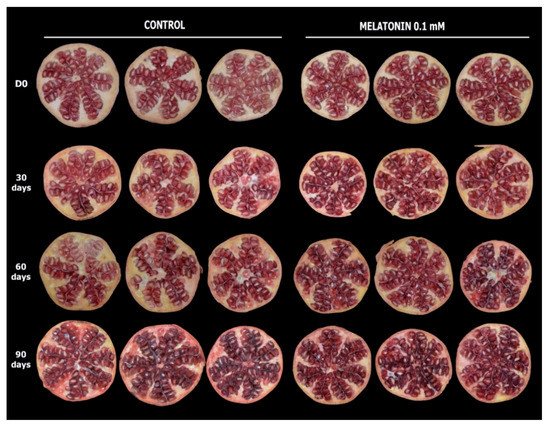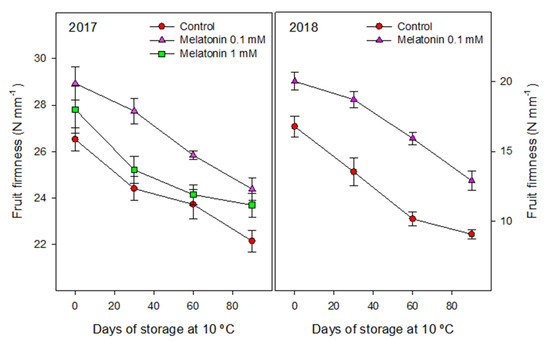With the aim to study the effect of melatonin treatment of pomegranate trees on crop yield and fruit quality at harvest and during storage, two experiments were carried out in two consecutive years: 2017 and 2018. In the first year, trees were treated with melatonin (at 0.1 and 1 mM) along the developmental growth cycle and fruit quality parameters were evaluated at harvest and during storage at 10 °C for 90 days. Treatments with melatonin led to an increase of crop yield (number of fruits per tree and kg per tree), as well as higher fruit quality attributes, such as fruit size (diameter and weight), color, total soluble solids (TSS), and total acidity (TA), especially with the 0.1 mM dose. Then, in the second year, melatonin at 0.1 mM was selected for repeating the pre-harvest treatments with similar results in terms of crop yield and fruit quality parameters. During storage, pomegranate fruit treated with 0.1 mM melatonin maintained higher quality attributes than controls, such as TSS, TA, and firmness and lower weight losses were observed in fruit from treated trees, in both trials. In addition, the content of the major sugars (glucose and fructose) and organic acids (malic, succinic and ascorbic acid) were higher in melatonin-treated than in non-treated fruit. These results suggest that pre-harvest melatonin treatment could be a useful tool to increase pomegranate crop yield as well as fruit quality parameters at harvest and their maintenance during storage due to an effect of melatonin on reducing the postharvest ripening process.
1. Introduction
Melatonin (N-acetyl-5-methoxytryptamine) is a natural-occurring compound derivative of tryptamine, and plays important roles in plant growth, such as delay of senescence process and increased tolerance to both biotic and abiotic stress
[1]. These effects have been attributed to the melatonin action as a natural antioxidant molecule scavenging free radicals either in vitro as in vivo studies using different vascular plants
[2]. The melatonin content in edible fruit has been associated with health-benefits, since high levels of this compound in foods are beneficial for consumers. Thus, the consumption of a Jerte Valley cherry product enhances mood and increases 5-hydroxyindoleacetic acid but reduces cortisol levels in urine, which may protect against stress and act as a mood enhancer by increasing serotonin availability in the organism, particularly with advancing age
[3].
As postharvest treatments, melatonin delayed physiological deterioration of cassava roots and reduced the accumulation of H
2O
2 while increasing the activity of antioxidant enzymes, and thus maintaining homeostasis of cellular reactive oxygen species (ROS) through increasing the endogenous melatonin levels
[4]. In tomato fruit, postharvest treatment with melatonin at 50 µM stimulated the content of anthocyanins, and might be positively related to fruit ripening but negatively related to fruit senescence, since the proteins related with senescence were downregulated while an increase of catalase and peroxidase was observed in treated fruit
[5]. In peaches, postharvest application of melatonin at 0.1 mM reduced weight loss, decay incidence, and respiration rate as well as maintained firmness, total soluble solids and ascorbic acid contents during seven days of storage at 25–28 °C, with a concomitant increase in antioxidant enzymes and maintenance of membrane integrity, which might be a part of the mechanism implicated on delaying senescence in peach fruit
[6].
As pre-harvest treatment, very little evidence exists about the role of melatonin on fruit growth and ripening, and different effects have been reported depending on fruit species, concentration, or time of application. Thus, melatonin was naturally found in grape tissues (skin, flesh and seed), and, during ripening, melatonin content decreased in skin, while it increased in both seed and flesh tissues
[7]. Melatonin at 100 mg L
−1 (0.43 mM), applied once or twice to grapevines at pre-veraison stage, significantly increased (6.6%) the grape berry size, which was correlated with increased concentration of endogenous melatonin
[8]. In two cherry cultivars (‘Hondeng’ and ‘Rainier’), melatonin was evaluated during the growth cycle, and a maximum peak at stage 2 was found, which coincided with endocarp lignification in both cherry cultivars
[9] and in ‘Prime Giant’ sweet cherry, melatonin 0.1 and 0.01 mM applied at pit hardening inhibited fruit ripening
[10]. However, irrigation of tomato plants with 0.1 mM melatonin increased sugar and lycopene concentration in fruits, showing a positive effect on fruit ripening
[11], while, in apricots, foliar spray melatonin treatment increased yield and fruit weight, although no effect on on-tree ripening was observed
[12].
Pomegranate is one of the oldest known edible fruits which has gained popularity and scientific interest in the last several years due to its nutritional value and health benefits, since it is very rich in bioactive compounds with antioxidant activity
[13,14][13][14]. The quality parameters for pomegranate are based on external attributes such as size, shape, and color of the skin, as well as on internal ones such as aril color, sugar and acid content, and the presence of small and soft seeds
[15,16][15][16]. The color of the pomegranate increases in both skin and arils during ripening, due to the accumulation of anthocyanins, the major in the sweet varieties being cyanidin 3-glucoside, followed by delphinidin 3,5-diglucoside and pelargonidin 3-glucoside, as well as sugar content, while decreases occur on acid content and fruit firmness
[16,17,18,19][16][17][18][19]. However, during postharvest storage, pomegranate exhibits important quality losses due to several physiological and enzymatic disorders, the major ones being weight loss, together with loss of firmness, aril color, and acidity, which lead to a reduction of consumers’ acceptability in terms of freshness, juiciness, and taste
[15,16,19,20,21][15][16][19][20][21].
2. Effect of Pre-Harvest Melatonin Treatment on Crop Yield
Fruit diameter was recorded during on-tree fruit growth and ripening and results are shown in , in which a simple-sigmoid growth curve from full blossom (FB) to harvest (155 d after full blossom, DAFB) can be observed. In addition, results showed that melatonin treatment at 0.1 mM concentration stimulated fruit growth from the second application (T2), leading to pomegranates with significantly higher size (
p < 0.05) in 0.1 mM melatonin-treated trees (≈84 mm) than in 1 mM or control ones (≈79 and 77 mm, respectively) at the first harvest date. The increase of fruit size as a consequence of 0.1 mM melatonin treatment was not due to an increased peel width but to an increase in the portion of the arils, as can be observed in the photograph of cut pomegranate fruit detailed below.
Figure 1. Evolution of fruit size (diameter) during pomegranate development from full blossom (FB) to harvest, in fruit from control and 0.1 or 1 mM melatonin-treated trees. T1–T5 represent the day of treatment. Data are the mean ± SE.
With respect to yield, the results of the 2017 experiment are presented in , showing that both the number of fruit harvested by tree and kg of fruit harvested by tree were significantly higher (
p < 0.05) in 0.1 mM melatonin-treated trees than in controls, although these increases were not significant in 1 mM melatonin treated trees. In addition, fruit ripening was delayed in treated trees, since yield at the first harvest date was significantly (
p < 0.05) higher in control trees (28.65 ± 3.16 kg tree
−1) than in those treated with 0.1 and 1 mM melatonin doses (ca. 21 kg tree
−1), as well as the number of fruit per tree (78.0 ± 7.9, 61.40 ± 4.01 and 65.00 ± 3.83 for control and 0.1 and 1 mM melatonin treated trees, respectively). The average fruit weight, taking into account data from the two harvest dates, was significantly higher (
p < 0.05) in fruit from 0.1 mM melatonin treated than from controls, although no significant effect was observed with 1 mM melatonin treatment. However, since total yield per tree was only significantly increased in 0.1 mM melatonin treated trees, this concentration was used in the next year, in which these effects were confirmed. Thus, higher values of kg tree
−1, the number of fruits per tree and average fruit weight were obtained in 0.1 mM-melatonin treated trees compared with control ones ().
Table 1. Data for yield (kg tree−1 and number of fruit tree−1), and fruit weight in control and melatonin-treated pomegranate trees (0.1 and 1 mM) at two harvest dates (1 and 2). Year 2017.
| Parameter |
Control |
Melatonin 0.1 mM |
Melatonin 1 mM |
| Yield (kg tree−1) |
|
|



